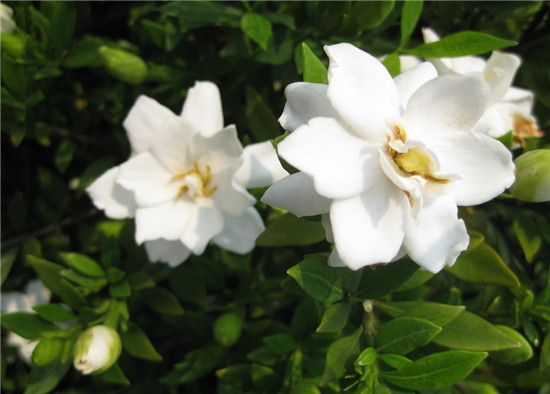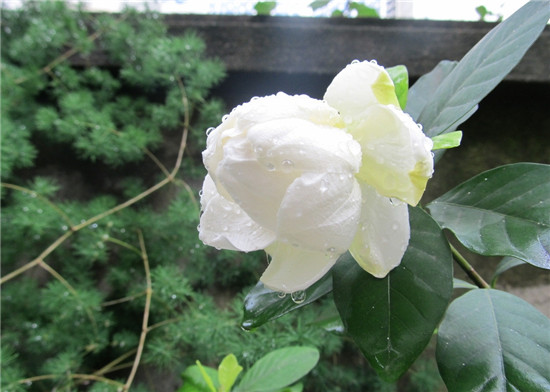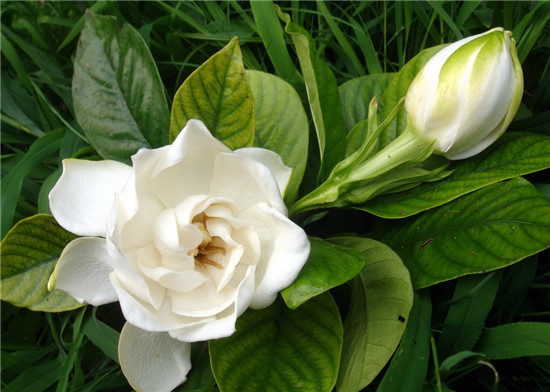How to grow Gardenia jasminoides
Big-leaf gardenia is also a variety of gardenia. Do you know big-leaf gardenia? Want to know how to grow it? Let's get to know it together.

Morphological characteristics of Gardenia jasminoides
Evergreen shrubs. Branches clustered, dry gray, branchlets green. Leaves large, opposite or tricuspidate, 7-14 cm long and 2-5 cm wide, with short stalks, leathery, Obovate or rectangular-Obovate, apex acuminate, dark green, glossy, stipule sheathlike. Large white flowers bloom in June, and the largest flowers can reach 10cm. Solitary in branch ends or leaf axils, ca. 7 cm in diam., white, extremely fragrant; calyx lobes 6, linear; Corolla lobes broadly oblanceolate; stamens 6, anthers linear; ovary inferior, 1-loculed, style thick, stigma clavate. The fruit is Obovate or long oval, 3-7 cm long, 1-1.5 cm in diameter, yellow, with high longitudinal edges, thick pericarp and persistent calyx. Double, full-bodied, with short stalks. Northern conservation of Gardenia jasminoides is often due to climate, soil and other conditions are not suitable for its growth and development, resulting in the leaves of Gardenia jasminoides turned yellow and even the whole plant died.
Key points of cultivation of Gardenia jasminoides
The cultivation of Gardenia jasminoides has strict requirements on the soil. It grows well in the acidic soil of pH5-6, while the soil in the north is generally neutral or alkaline. In this soil, due to the hydrolysis of iron salts, iron hydroxide insoluble in water is formed, which can not be absorbed by plants, resulting in serious iron deficiency. Although iron is not a component of chlorophyll, it is a necessary condition for the formation of chlorophyll, so iron deficiency blocks the synthesis of chlorophyll, so photosynthesis can not be carried out normally, which is the main cause of plant starvation and death.

In addition, iron is a component of some oxidases and plays an important role in respiration. If the gardenia jasminoides is iron deficient, it will affect the normal physiological activity of the plant. To solve the problem of iron deficiency, the method of watering "alum fertilizer water" can achieve good results. In addition, a small amount of black alum powder can also be added to the basin soil, the dosage is 0.5% of the weight of the basin soil, and 0.5% of 1.0% black alum water is poured every 10-15 days during the growing season, which can also ensure the iron requirements of gardenia, so that it can grow and develop normally.
Culture method of Gardenia jasminoides
The main results are as follows: (1) Gardenia likes acidic soil, while most of the soils in the north are neutral or alkaline, which leads to the lack of iron that can be used by plants, which is one of the main reasons for the yellowing of leaves. To this end, the cultivation of Gardenia jasminoides should choose fertile acid culture soil. Generally, it can be mixed with 4 parts of rotten leaf soil, 4 parts of garden soil and 2 parts of sandy soil. Then cultivate 1-2 grams of sulfur powder per kilogram of soil. Rain Water or fermented rice panning water is suitable for watering gardenia. During the growth period, 0.2% ferrous sulfate is poured every 10-15 days or alum fertilizer is applied every 10-15 days (the two can be carried out alternately). This can not only prevent the soil from turning sour, but also replenish the soil with iron in time, thus preventing the leaves from turning yellow.

(2) Gardenia likes to be moist. In addition to keeping the basin soil moist at ordinary times, we must also pay attention to increasing air humidity. This is because the climate of the north is different from that of the south. The north is dry in spring, often blows dry winds, strong light intensity in summer, hot weather, and cold and dry winter. Therefore, in spring and summer, it is necessary to spray foliage with clear water every morning and evening and sprinkle water to the nearby ground to increase air humidity. Watering should be less in winter, but branches and leaves still need to be sprayed and washed frequently to keep the leaves clean.
(3) Gardenia likes light, but is afraid of strong light exposure. If exposed to the sun, the leaves turn yellow and whiten until they fall off. Therefore, the summer must be placed under the shade or in a place with scattered light, so that it can see some sunlight in the morning and evening, so as to prevent the leaves from turning yellow.

(4) Gardenia jasminoides is not cold-resistant, so it is necessary to pay attention to the room and out of the room at the right time. It is generally in the middle of October to put it in the sunny place, and the room temperature should be kept at 10 ℃-12 ℃. It is not advisable to leave the room too early in the next spring, usually in late April. If the above four points can be achieved, gardenia can not only settle down in the north, but also have numerous green leaves and fragrant flowers.
The above is the whole content of how to grow gardenia and the planting method of gardenia. I hope this article can help you. Please continue to follow us.
Related
- Wuhan Hospital Iron Tree Blooming Result Was Instantly Frightened by the Gardener Master
- Which variety of camellia is the most fragrant and best? Which one do you like best?
- What is the small blue coat, the breeding methods and matters needing attention of the succulent plant
- Dormancy time and maintenance management of succulent plants during dormancy
- Minas succulent how to raise, Minas succulent plant pictures
- What are the varieties of winter succulent plants
- How to raise succulent plants in twelve rolls? let's take a look at some experience of breeding twelve rolls.
- Attention should be paid to water control for succulent plants during dormant period (winter and summer)
- Watering experience of twelve rolls of succulent plants
- Techniques for fertilizing succulent plants. An article will let you know how to fertilize succulent plants.



